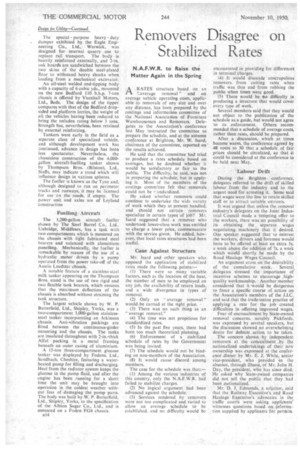Removers Disagree on Stabilized Rates
Page 48

If you've noticed an error in this article please click here to report it so we can fix it.
N.A.F.W.R. to Raise the Matter Again in the Spring
ARATES structure based on an ':..average removal" and on average vehicle operating costs, applicable to removals of any size and over any distance, has been prepared by the costings and information committee of the National Association of Furniture Warehousemen and Removers. Delegates to the Association's conference last May instructed the committee to prepare the schedule, and at the autumn conference at Brighton, Mr. W. Isard, chairman of the committee, reported on ' the results achieved.
He said that the committee had tried to produce a rates schedule based on averages, but he doubted whether it would be satisfactory or fair to the public. The difficulty, he said, was not in preparing the schedule, but in applying it. Most of the members of the costings committee felt that removals could not be r.tandardized.
He asked whether removers could continue to undertake the wide variety of work which they at present handled, and should not certain removers specialize in certain types of job? Mr. Isard suggested that a remover who undertook lower-class work was entitled to charge a lower price, commensurate with the service given. He added, hemever, that local rates structures had been useful.
Case Against Structure
Mr. Isard and other speakers who opposed the application of stabilized rates made the following points:— ( I) There were so many variable factors, such as the location of the base, the number of men to be employed on any job, the availability of return loads. and a wide divergence in types of removal.
(2) Only an " average removal" would be carried at the night price.
(3) There was no such thing as an "average removal."
(4) The time was not propitious for standardized rates.
(5) In the past five years, there had been too much theoretical planning.
(6) Enforcement of a stabilized schedule of rates by the Government was being invited.
(7) The schedule would not be binding on non-members of the Association.
(8) It would cause discord among members. The case for the schedule was that:— I I) Among the various industries of this country, only the N.A.F.W.R. had failed to stabilize charges.
(2) No logical argument had been advanced against the schedule.
(3) Services rendered by removers were not too complicated and varied to allow an average schedule to be established, and no difficulty would be encountered in providing for differencei in terminal charges.
(4) It would dissuade unscrupulous removers from cutting rates when traffic was thin and from robbing the public when times were good.
(5) There would be no difficulty in producing a structure that would cover every type of work.
Several members said that they would not object to the publication of the schedule as a guide, but would not agree to its enforcement. Others recommended that a schedule of average costs, rather than rates, should be prepared.
After a discussion, which at times became warm, the conference agreed by 48 votes to 30 that a schedule of fair prices should be circulated, so that it could be considered at the conference to be held next May.
Labour Drift During the Brighton conference, delegates referred to the drift of skilled labour from the industry and to the urgent need for arresting it. Some said that wages were too low to retain skilled staff or to attract suitable entrants.
It was argued that unless the removal industry's delegates on the Joint Industrial Council made a tempting offer to the workers, there was no possibility of its obtaining the separate wages negotiatingmachinery that it desired. One speaker suggested that to interest the workers, drivers and foremen would have to 'be offered at least an extra is. a week above the addition of 7s. a week which would shortly be made by the Road Haulage Wages Council.
An argument arose on the desirability , of the cumulative week. Several. delegates stressed the importance of incentive schemes to encourage highquality workmanship. • Another member considered that it would be dangerous to force a specific course of action on the Association's members of the J.1.C. and said that the trade-union practice of applying a rate for the job created difficulties in offering improved wages.
Fear of encroachment by State-owned removal concerns, notably Pickfords, was expressed by several speakers, but the discussion showed no overwhelming desire for definite action to be taken.
The concern shown by independent removers at the concealment by the nationalized undertakings of their new ownership was expressed at the conference dinner by Mr. E. I. White, senior vice-president, who presided in the absence, through illness, of Mr. John H. Day, the president, who has since died. He asked why State-owned companies did not tell the public that they had been .nationalized.
Mr. D. J. Edmonds, a solicitor, said that the Railway Executive's and Road Haulage • Executive's advocates in the traffic courts were asking applicants' witnesses questions based on information supplied by applicants for permits.




















































































